Hydrological Factor and Land Use/Land Cover Change Explain the Vegetation Browning in the Dosso Reserve, Niger
Abstract
:1. Introduction
2. Data Sources and Methods
2.1. Study Area
2.2. Data Sources and Pre-Processing
2.3. Methods
- NDVI trend analysis to detect where the vegetation was greening or browning. We used the Theil–Sen method to detect the temporal trends in annual mean NDVI both inside and outside the protected area in the Dosso Reserve at the pixel scale and the regional scale.
- Driving factor analysis to determine how environmental variables influence the vegetation greenness change. We performed a regional RF model-based method to assess the relative contributions of different factors, i.e., air temperature (Tem), precipitation (P), solar radiation (Rad), vapor pressure deficit (VPD), soil moisture (SM), LULC fractions (Crop, Forest, Grass, Shrub, Wetland, Water, Settlement, and Bare), and population (Pop) to vegetation browning and greening, respectively.
- Investigation of the response of NDVI to dominant drivers. After identifying the dominant drivers, we explored the response of vegetation greenness to the dominant drivers using the PDP tool.
2.3.1. Theil–Sen Trend Analysis Approach
2.3.2. Random Forest Model-Based Driver Analysis
- (1)
- Randomly select 1000 points (samples) in the entire study area and extract the NDVI (dependent variable) and a total of 14 influencing factors (independent variables) at each point over the period 2001–2020.
- (2)
- Implement an RF configuration with 5-fold cross-validation and ntree = 500 to determine the optimal hyper-parameters according to the grid search method with varied hyper-parameters (Table 3) for all points. The coefficient of determination (R2) and the root-mean-squared error (RMSE) of the cross-validation were calculated.
- (3)
- The optimal hyper-parameter setting was determined by the minimum RMSE criterion (0.032) with an R2 value of 0.715. The optimized parameters are shown in Table 3.
2.3.3. Partial Dependence Plot to Analyze the Response of NDVI to Dominant Drivers
3. Results
3.1. Vegetation Greenness Change by the NDVI Trend Analysis
3.2. The Importance of Different Drivers
3.3. Response of NDVI to Dominant Drivers
4. Discussion
4.1. Trends in Vegetation Greenness inside and outside the Protected Area
4.2. Drivers of Vegetation Greenness Dynamics
4.3. Implications for Social–Ecological Sustainability
- (1)
- Land management strategies should be improved and strengthened in the Dosso Reserve. The issue of relaxed management practices should be addressed by implementing stricter and more effective management strategies within the Dosso Reserve. This includes enhancing enforcement of regulations, improving surveillance, and employing trained personnel to ensure proper protection and conservation efforts. Establishing comprehensive and well-structured long-term planning for the Dosso Reserve should involve setting clear conservation goals, defining strategies for achieving those goals, and outlining specific actions to be taken over an extended period. Regular assessments of the ecological health, biodiversity, and the effectiveness of protective measures in the reserve will enable better decision-making and the timely identification of emerging threats.
- (2)
- The issue of inadequate water supply, especially soil moisture stress, and implementing strategies to ensure sustainable use of water resources should be addressed. Possible management responses to the widespread water-holding capacity limitations include improving irrigation infrastructure, measures to increase soil organic matter, and using drought-tolerant or drought-avoiding crop varieties.
- (3)
- Sustainable land use practices should be improved and promoted to protect habitats. Encourage sustainable agricultural practices and discourage unsustainable activities such as expansion of agriculture, deforestation, and excessive grazing within the Dosso Reserve. This can be achieved through awareness campaigns, capacity-building programs, and providing incentives for adopting environmentally friendly practices.
- (4)
- Local implementation of vegetation restoration strategies, such as reforestation, grassland restoration, and soil conservation, is crucial to promote vegetation recovery and ecosystem health. Specific measures to address vegetation loss and land degradation in areas most affected should be deployed, particularly in the western region of the Dosso Reserve. In particular, it is necessary to provide local communities with the skills and tools they need to restore the land and generate income from tree products (e.g., fruits and nuts), rather than expanding farmland through extensive land clearance and shrub removal.
- (5)
- Protected area managers should collaborate with neighboring communities and the government to develop transboundary conservation and sustainable development strategies. To ensure the long-term sustainability of the ecosystem in the region, it is important that they work together to address both environmental and livelihood challenges.
5. Conclusions
Author Contributions
Funding
Data Availability Statement
Conflicts of Interest
References
- IPBES. Global Assessment Report on Biodiversity and Ecosystem Services of the Intergovernmental Science-Policy Platform on Biodiversity and Ecosystem Services; IPBES Secretariat: Bonn, Germany, 2019. [Google Scholar]
- Carvalho, F.P. Conservation of the last savannah animals in West Africa: Challenges and call for action. Int. J. Environ. Stud. 2020, 77, 1024–1043. [Google Scholar] [CrossRef]
- Fu, B.; Stafford-Smith, M.; Wang, Y.; Wu, B.; Yu, X.; Lv, N.; Ojima, D.S.; Lv, Y.; Fu, C.; Liu, Y.; et al. The Global-DEP conceptual framework-research on dryland ecosystems to promote sustainability. Curr. Opin. Env. Sust. 2021, 48, 17–28. [Google Scholar] [CrossRef]
- Milas, S. Population crisis and desertification in the Sudano-Sahelian Region. Environ. Conserv. 1984, 11, 167–169. [Google Scholar] [CrossRef] [PubMed]
- Fensholt, R.; Mbow, C.; Brandt, M.; Rasmussen, K. Desertification and Re-Greening of the Sahel. In Oxford Research Encyclopedia of Climate Science; Oxford University: Oxford, UK, 2017. [Google Scholar]
- Kusserow, H. Desertification, resilience, and re-greening in the African Sahel—A matter of the observation period? Earth Syst. Dynam 2017, 8, 1141–1170. [Google Scholar] [CrossRef]
- Fishpool, L.D.; Evans, M.I. Important Bird Areas in Africa and Associated Islands: Priority Sites for Conservation; BirdLife International Cambridge: Cambridge, UK, 2001. [Google Scholar]
- IUCN. Protected Areas of the World: A Review of National Systems. In Afrotropical; IUCN: Gland, Switzerland; Cambridge, UK, 1992; Volume 3. [Google Scholar]
- Dardel, C.; Kergoat, L.; Hiernaux, P.; Mougin, E.; Grippa, M.; Tucker, C.J. Re-greening Sahel: 30 years of remote sensing data and field observations (Mali, Niger). Remote Sens. Environ. 2014, 140, 350–364. [Google Scholar] [CrossRef]
- Kaptué, A.T.; Prihodko, L.; Hanan, N.P. On regreening and degradation in Sahelian watersheds. Proc. Natl. Acad. Sci. USA 2015, 112, 12133–12138. [Google Scholar] [CrossRef] [PubMed]
- Rasmussen, K.; D’Haen, S.; Fensholt, R.; Fog, B.; Horion, S.; Ostergaard Nielsen, J.; Vang Rasmussen, L.; Reenberg, A. Environmental change in the Sahel: Reconciling contrasting evidence and interpretations. Reg. Environ. Chang. 2016, 16, 673–680. [Google Scholar] [CrossRef]
- Ogutu, B.O.; D’Adamo, F.; Dash, J. Impact of vegetation greening on carbon and water cycle in the African Sahel-Sudano-Guinean region. Glob. Planet. Chang. 2021, 202, 103524. [Google Scholar] [CrossRef]
- Leroux, L.; Bégué, A.; Lo Seen, D. Regional analysis of crop and natural vegetation in West Africa based on NDVI metrics. In Proceedings of the IEEE Geoscience and Remote Sensing Symposium, Quebec, QC, Canada, 13–18 July 2014; pp. 5107–5110. [Google Scholar]
- Leroux, L.; Bégué, A.; Lo Seen, D.; Jolivot, A.; Kayitakire, F. Driving forces of recent vegetation changes in the Sahel: Lessons learned from regional and local level analyses. Remote Sens. Environ. 2017, 191, 38–54. [Google Scholar] [CrossRef]
- Jiang, M.; Jia, L.; Menenti, M.; Zeng, Y. Understanding spatial patterns in the drivers of greenness trends in the Sahel-Sudano-Guinean region. Big Earth Data 2022, 7, 298–317. [Google Scholar] [CrossRef]
- Zeng, Y.; Jia, L.; Menenti, M.; Jiang, M.; Barnieh, B.A.; Bennour, A.; Lv, Y. Changes in vegetation greenness related to climatic and non-climatic factors in the Sudano-Sahelian region. Reg. Environ. Chang. 2023, 23, 92. [Google Scholar] [CrossRef]
- Cotillon, S.E.; Tappan, G.G. Landscapes of West Africa: A Window on a Changing World; United States Geological Survey: Garretson, SD, USA, 2016. [Google Scholar]
- Herrmann, S.M.; Brandt, M.; Rasmussen, K.; Fensholt, R. Accelerating land cover change in West Africa over four decades as population pressure increased. Commun. Earth Environ. 2020, 1, 53. [Google Scholar] [CrossRef]
- Clerici, N.; Bodini, A.; Eva, H.; Grégoire, J.-M.; Dulieu, D.; Paolini, C. Increased isolation of two Biosphere Reserves and surrounding protected areas (WAP ecological complex, West Africa). J. Nat. Conserv. 2007, 15, 26–40. [Google Scholar] [CrossRef]
- Tang, X.; Adesina, J.A. Biodiversity conservation of national parks and nature-protected areas in West Africa: The case of Kainji National Park, Nigeria. Sustainability 2022, 14, 7322. [Google Scholar] [CrossRef]
- Henschel, P.; Coad, L.; Burton, C.; Chataigner, B.; Dunn, A.; MacDonald, D.; Saidu, Y.; Hunter, L.T. The lion in West Africa is critically endangered. PLoS ONE 2014, 9, e83500. [Google Scholar] [CrossRef] [PubMed]
- Gašparová, K.; Fennessy, J.; Moussa Zabeirou, A.R.; Abagana, A.L.; Rabeil, T.; Brandlová, K. Saving the last West African Giraffe population: A review of its conservation status and management. Animals 2024, 14, 702. [Google Scholar] [CrossRef] [PubMed]
- Houehanou, T.D.; Assogbadjo, A.E.; Kakaï, R.G.; Kyndt, T.; Houinato, M.; Sinsin, B. How far a protected area contributes to conserve habitat species composition and population structure of endangered African tree species (Benin, West Africa). Ecol. Complex. 2013, 13, 60–68. [Google Scholar] [CrossRef]
- Garba, H.H.M.; Di Silvestre, I. Conflicts between large carnivores and domestic livestock in the peripheral zone of the W transboundary Park in Niger. In Proceedings of the Management and Conservation of Large Carnivores in West and Central Africa, Maroua, Cameroon, 15–16 November 2006; pp. 133–144. [Google Scholar]
- Abdou, I.K.; Abasse, T.; Massaoudou, M.; Rabiou, H.; Soumana, I.; Bogaert, J. Influence des pressions anthropiques sur la dynamique paysagère de la Reserve Partielle de Faune de Dosso (Niger). Int. J. Biol. Chem. Sci. 2019, 13, 1094–1108. [Google Scholar] [CrossRef]
- Fensholt, R.; Rasmussen, K. Analysis of trends in the Sahelian ‘rain-use efficiency’ using GIMMS NDVI, RFE and GPCP rainfall data. Remote Sens. Environ. 2011, 115, 438–451. [Google Scholar] [CrossRef]
- Pettorelli, N.; Chauvenet, A.L.; Duffy, J.P.; Cornforth, W.A.; Meillere, A.; Baillie, J.E. Tracking the effect of climate change on ecosystem functioning using protected areas: Africa as a case study. Ecol. Indic. 2012, 20, 269–276. [Google Scholar] [CrossRef]
- Mishra, N.B.; Crews, K.A.; Neeti, N.; Meyer, T.; Young, K.R. MODIS derived vegetation greenness trends in African Savanna: Deconstructing and localizing the role of changing moisture availability, fire regime and anthropogenic impact. Remote Sens. Environ. 2015, 169, 192–204. [Google Scholar] [CrossRef]
- Hua, T.; Zhao, W.; Cherubini, F.; Hu, X.; Pereira, P. Effectiveness of protected areas edges on vegetation greenness, cover and productivity on the Tibetan Plateau, China. Landscape Urban. Plan. 2022, 224, 104421. [Google Scholar] [CrossRef]
- Liu, L.; Gudmundsson, L.; Hauser, M.; Qin, D.; Li, S.; Seneviratne, S.I. Soil moisture dominates dryness stress on ecosystem production globally. Nat. Commun. 2020, 11, 4892. [Google Scholar] [CrossRef] [PubMed]
- Piao, S.; Wang, X.; Park, T.; Chen, C.; Lian, X.; He, Y.; Bjerke, J.W.; Chen, A.; Ciais, P.; Tømmervik, H.; et al. Characteristics, drivers and feedbacks of global greening. Nat. Rev. Earth Environ. 2020, 1, 14–27. [Google Scholar] [CrossRef]
- Tagesson, T.; Tian, F.; Schurgers, G.; Horion, S.; Scholes, R.; Ahlström, A.; Ardö, J.; Moreno, A.; Madani, N.; Olin, S.; et al. A physiology-based Earth observation model indicates stagnation in the global gross primary production during recent decades. Glob. Chang. Biol. 2021, 27, 836–854. [Google Scholar] [CrossRef]
- Zhang, Z.; Ju, W.; Zhou, Y.; Li, X. Revisiting the cumulative effects of drought on global gross primary productivity based on new long-term series data (1982–2018). Glob. Chang. Biol. 2022, 28, 3620–3635. [Google Scholar] [CrossRef]
- Epule, E.T.; Peng, C.; Lepage, L.; Chen, Z. The causes, effects and challenges of Sahelian droughts: A critical review. Reg. Environ. Chang. 2014, 14, 145–156. [Google Scholar] [CrossRef]
- Yuan, W.; Zheng, Y.; Piao, S.; Ciais, P.; Lombardozzi, D.; Wang, Y.; Ryu, Y.; Chen, G.; Dong, W.; Hu, Z.; et al. Increased atmospheric vapor pressure deficit reduces global vegetation growth. Sci. Adv. 2019, 5, eaax1396. [Google Scholar] [CrossRef]
- Abdi, A.M.; Boke-Olén, N.; Tenenbaum, D.E.; Tagesson, T.; Cappelaere, B.; Ardö, J. Evaluating water controls on vegetation growth in the semi-arid Sahel using field and Earth observation data. Remote Sens. 2017, 9, 294. [Google Scholar] [CrossRef]
- Wei, F.; Wang, S.; Fu, B.; Wang, L.; Liu, Y.Y.; Li, Y. African dryland ecosystem changes controlled by soil water. Land. Degrad. Dev. 2019, 30, 1564–1573. [Google Scholar] [CrossRef]
- Rasmussen, K.; Fensholt, R.; Fog, B.; Vang Rasmussen, L.; Yanogo, I. Explaining NDVI trends in northern Burkina Faso. Geogr. Tidsskr.-Dan. J. Geogr. 2014, 114, 17–24. [Google Scholar] [CrossRef]
- Tappan, G.G.; Sall, M.; Wood, E.C.; Cushing, M. Ecoregions and land cover trends in Senegal. J. Arid. Environ. 2004, 59, 427–462. [Google Scholar] [CrossRef]
- Tong, X.; Brandt, M.; Hiernaux, P.; Herrmann, S.M.; Tian, F.; Prishchepov, A.V.; Fensholt, R. Revisiting the coupling between NDVI trends and cropland changes in the Sahel drylands: A case study in western Niger. Remote Sens. Environ. 2017, 191, 286–296. [Google Scholar] [CrossRef]
- Li, W.; Migliavacca, M.; Forkel, M.; Denissen, J.M.C.; Reichstein, M.; Yang, H.; Duveiller, G.; Weber, U.; Orth, R. Widespread increasing vegetation sensitivity to soil moisture. Nat. Commun. 2022, 13, 3959. [Google Scholar] [CrossRef]
- Breiman, L. Random forests. Mach. Learn. 2001, 45, 5–32. [Google Scholar] [CrossRef]
- Friedman, J.H. Greedy function approximation: A gradient boosting machine. Ann. Stat. 2001, 29, 1189–1232. [Google Scholar] [CrossRef]
- Zhou, J.; Jia, L.; Menenti, M.; Liu, X. Optimal estimate of global biome-specific parameter settings to reconstruct NDVI time series with the harmonic analysis of time series (HANTS) method. Remote Sens. 2021, 13, 4251. [Google Scholar] [CrossRef]
- Zhou, J.; Jia, L.; van Hoek, M.; Menenti, M.; Lu, J.; Hu, G. An optimization of parameter settings in HANTS for global NDVI time series reconstruction. In Proceedings of the 2016 IEEE International Geoscience and Remote Sensing Symposium (IGARRS), Beijing, China, 10–15 July 2016; pp. 3422–3425. [Google Scholar]
- Menenti, M.; Azzali, S.; Verhoef, W.; Vanswol, R. Mapping agroecological zones and time lag in vegetation growth by means of fourier analysis of time series of NDVI images. Adv. Space Res. 1993, 13, 233–237. [Google Scholar] [CrossRef]
- Verhoef, W.; Menenti, M.; Azzali, S. Cover A colour composite of NOAA-AVHRR-NDVI based on time series analysis (1981–1992). Int. J. Remote Sens. 1996, 17, 231–235. [Google Scholar] [CrossRef]
- Keys, R. Cubic convolution interpolation for digital image processing. IEEE Trans. Acoust. Speech Signal Process. 1981, 29, 1153–1160. [Google Scholar] [CrossRef]
- Zhang, X.; Zhao, T.; Xu, H.; Liu, W.; Wang, J.; Chen, X.; Liu, L. GLC_FCS30D: The first global 30 m land-cover dynamics monitoring product with a fine classification system for the period from 1985 to 2022 generated using dense-time-series Landsat imagery and the continuous change-detection method. Earth Syst Sci Data 2024, 16, 1353–1381. [Google Scholar] [CrossRef]
- Ahmedou, O.C.A.; Nagasawa, R.; Osman, A.E.; Hattori, K. Rainfall variability and vegetation dynamics in the Mauritanian Sahel. Clim. Res. 2008, 38, 75–81. [Google Scholar] [CrossRef]
- Chen, C.; Park, T.; Wang, X.; Piao, S.; Xu, B.; Chaturvedi, R.K.; Fuchs, R.; Brovkin, V.; Ciais, P.; Fensholt, R.; et al. China and India lead in greening of the world through land-use management. Nat. Sustain. 2019, 2, 122–129. [Google Scholar] [CrossRef] [PubMed]
- Yue, S.; Pilon, P.; Phinney, B.; Cavadias, G. The influence of autocorrelation on the ability to detect trend in hydrological series. Hydrol. Process 2002, 16, 1807–1829. [Google Scholar] [CrossRef]
- Wright, M.N.; Ziegler, A. ranger: A fast implementation of random forests for high dimensional data in C++ and R. J. Stat. Softw. 2015, 77, 1–17. [Google Scholar] [CrossRef]
- Olsson, L.; Eklundh, L.; Ardö, J. A recent greening of the Sahel—Trends, patterns and potential causes. J. Arid. Environ. 2005, 63, 556–566. [Google Scholar] [CrossRef]
- Hickler, T.; Eklundh, L.; Seaquist, J.W.; Smith, B.; Ardö, J.; Olsson, L.; Sykes, M.T.; Sjöström, M. Precipitation controls Sahel greening trend. Geophys. Res. Lett. 2005, 32, L21415. [Google Scholar] [CrossRef]
- Herrmann, S.M.; Anyamba, A.; Tucker, C.J. Recent trends in vegetation dynamics in the African Sahel and their relationship to climate. Glob. Environ. Chang. 2005, 15, 394–404. [Google Scholar] [CrossRef]
- Dardel, C.; Kergoat, L.; Hiernaux, P.; Grippa, M.; Mougin, E.; Ciais, P.; Nguyen, C.-C. Rain-use-efficiency: What it tells us about the conflicting Sahel greening and Sahelian paradox. Remote Sens. 2014, 6, 3446–3474. [Google Scholar] [CrossRef]
- Avakoudjo, J.; Mama, A.; Toko, I.; Kindomihou, V.; Sinsin, B. Dynamics of land use in the W National Park and its surrounding northwest of Benin. Int. J. Biol. Chem. Sci. 2014, 8, 2608–2625. [Google Scholar] [CrossRef]
- Janssens, I.; de Bisthoven, L.J.; Rochette, A.-J.; Kakaï, R.G.; Akpona, J.D.T.; Dahdouh-Guebas, F.; Hugé, J. Conservation conflict following a management shift in Pendjari National Park (Benin). Biol. Conserv. 2022, 272, 109598. [Google Scholar] [CrossRef]
- Fu, Z.; Ciais, P.; Prentice, I.C.; Gentine, P.; Makowski, D.; Bastos, A.; Luo, X.; Green, J.K.; Stoy, P.C.; Yang, H.; et al. Atmospheric dryness reduces photosynthesis along a large range of soil water deficits. Nat. Commun. 2022, 13, 989. [Google Scholar] [CrossRef]
- Suzuki, R.; Higuchi, A. Vegetation response to soil moisture and groundwater in west-central Africa revealed by satellite observations. Hydrol. Sci. J. 2022, 67, 1153–1164. [Google Scholar] [CrossRef]
- Yao, Y.; Liu, Y.; Zhou, S.; Song, J.; Fu, B. Soil moisture determines the recovery time of ecosystems from drought. Glob. Chang. Biol. 2023, 29, 3562–3574. [Google Scholar] [CrossRef] [PubMed]
- Ippolito, T.A.; Herrick, J.E.; Dossa, E.L.; Garba, M.; Ouattara, M.; Singh, U.; Stewart, Z.P.; Prasad, P.V.; Oumarou, I.A.; Neff, J.C. A comparison of approaches to regional land-use capability analysis for agricultural land-planning. Land 2021, 10, 458. [Google Scholar] [CrossRef]
- Barnieh, B.A.; Jia, L.; Menenti, M.; Zhou, J.; Zeng, Y. Mapping land use land cover transitions at different spatiotemporal scales in West Africa. Sustainability 2020, 12, 8565. [Google Scholar] [CrossRef]
- Kindo, A.I.; Abasse, T.; Soumana, I.; Bogaert, J.; Mahamane, A. Perceptions locales de la dynamique du paysage et de la faune: Cas de la Réserve Partielle de Faune de Dosso, Niger. Afr. Sci. Rev. Int. Sci. Technol. 2019, 15, 250–264. [Google Scholar]
- Fiorillo, E.; Maselli, F.; Tarchiani, V.; Vignaroli, P. Analysis of land degradation processes on a tiger bush plateau in South West Niger using MODIS and LANDSAT TM/ETM+ data. Int. J. Appl. Earth Obs. 2017, 62, 56–68. [Google Scholar] [CrossRef]
- Hiernaux, P.; Kalilou, A.A.; Kergoat, L.; Brandt, M.; Mougin, E.; Fitts, Y. Woody plant decline in the Sahel of western Niger (1996–2017): Is it driven by climate or land use changes? J. Arid. Environ. 2022, 200, 104719. [Google Scholar] [CrossRef]
- Peltier, R.; Akodewou, A.; Palou Madi, O.; Boubacar, A.; Sibelet, N. Agroforestry innovations in dryland area of Africa: Results of 40 years of research-action in North Cameroon and Dallol Dosso in Niger. In Proceedings of the Congrès Mondial d’Agroforesterie, Québec, QC, Canada, 17–20 July 2022. [Google Scholar]
- Larwanou, M.; Saadou, M. The role of human interventions in tree dynamics and environmental rehabilitation in the Sahel zone of Niger. J. Arid. Environ. 2011, 75, 194–200. [Google Scholar] [CrossRef]
- Reij, C.; Tappan, G.; Smale, M. Agroenvironmental Transformation in the Sahel: Another Kind of “Green Revolution”; International Food Policy Research Institute: Washington, DC, USA, 2009; pp. 7–33. [Google Scholar]
- Shono, K.; Cadaweng, E.A.; Durst, P.B. Application of assisted natural regeneration to restore degraded tropical forestlands. Restor. Ecol. 2007, 15, 620–626. [Google Scholar] [CrossRef]
- Brandt, M.; Romankiewicz, C.; Spiekermann, R.; Samimi, C. Environmental change in time series—An interdisciplinary study in the Sahel of Mali and Senegal. J. Arid. Environ. 2014, 105, 52–63. [Google Scholar] [CrossRef]
- Mainiero, R.; Kazda, M. Depth-related fine root dynamics of Fagus sylvatica during exceptional drought. Forest Ecol. Manag. 2006, 237, 135–142. [Google Scholar] [CrossRef]
- Poorter, H.; Niklas, K.J.; Reich, P.B.; Oleksyn, J.; Poot, P.; Mommer, L. Biomass allocation to leaves, stems and roots: Meta-analyses of interspecific variation and environmental control. New Phytol. 2012, 193, 30–50. [Google Scholar] [CrossRef] [PubMed]
- Freschet, G.T.; Roumet, C.; Comas, L.H.; Weemstra, M.; Bengough, A.G.; Rewald, B.; Bardgett, R.D.; De Deyn, G.B.; Johnson, D.; Klimešová, J. Root traits as drivers of plant and ecosystem functioning: Current understanding, pitfalls and future research needs. New Phytol. 2021, 232, 1123–1158. [Google Scholar] [CrossRef]
- Slette, I.J.; Hoover, D.L.; Smith, M.D.; Knapp, A.K. Repeated extreme droughts decrease root production, but not the potential for post-drought recovery of root production, in a mesic grassland. Oikos 2023, 2023, e08899. [Google Scholar] [CrossRef]
- Cheng, S.; Huang, J. Enhanced soil moisture drying in transitional regions under a warming climate. J. Geophys. Res. Atmos. 2016, 121, 2542–2555. [Google Scholar] [CrossRef]
- Berg, A.; Sheffield, J. Climate change and drought: The soil moisture perspective. Curr. Clim. Chang. Rep. 2018, 4, 180–191. [Google Scholar] [CrossRef]
- Yang, Y.; Roderick, M.L.; Guo, H.; Miralles, D.G.; Zhang, L.; Fatichi, S.; Luo, X.; Zhang, Y.; McVicar, T.R.; Tu, Z. Evapotranspiration on a greening Earth. Nat. Rev. Earth Environ. 2023, 4, 626–641. [Google Scholar] [CrossRef]
- Flexas, J.; Escalona, J.M.; Evain, S.; Gulias, J.; Moya, I.; Osmond, C.B.; Medrano, H. Steady-state chlorophyll fluorescence (Fs) measurements as a tool to follow variations of net CO2 assimilation and stomatal conductance during water-stress in C3 plants. Physiol. Plantarum 2002, 114, 231–240. [Google Scholar] [CrossRef]
- Hikosaka, K.; Tsujimoto, K. Linking remote sensing parameters to CO2 assimilation rates at a leaf scale. J. Plant Res. 2021, 134, 695–711. [Google Scholar] [CrossRef] [PubMed]
- Huang, F.; Zhang, Y.; Zhang, Y.; Nourani, V.; Li, Q.; Li, L.; Shangguan, W. Towards interpreting machine learning models for predicting soil moisture droughts. Environ. Res. Lett. 2023, 18, 074002. [Google Scholar] [CrossRef]
- Harris, N.C.; Mills, K.L.; Harissou, Y.; Hema, E.M.; Gnoumou, I.T.; VanZoeren, J.; Abdel-Nasser, Y.I.; Doamba, B. First camera survey in Burkina Faso and Niger reveals human pressures on mammal communities within the largest protected area complex in West Africa. Conserv. Lett. 2019, 12, e12667. [Google Scholar] [CrossRef]
- Craigie, I.D.; Baillie, J.E.; Balmford, A.; Carbone, C.; Collen, B.; Green, R.E.; Hutton, J.M. Large mammal population declines in Africa’s protected areas. Biol. Conserv. 2010, 143, 2221–2228. [Google Scholar] [CrossRef]


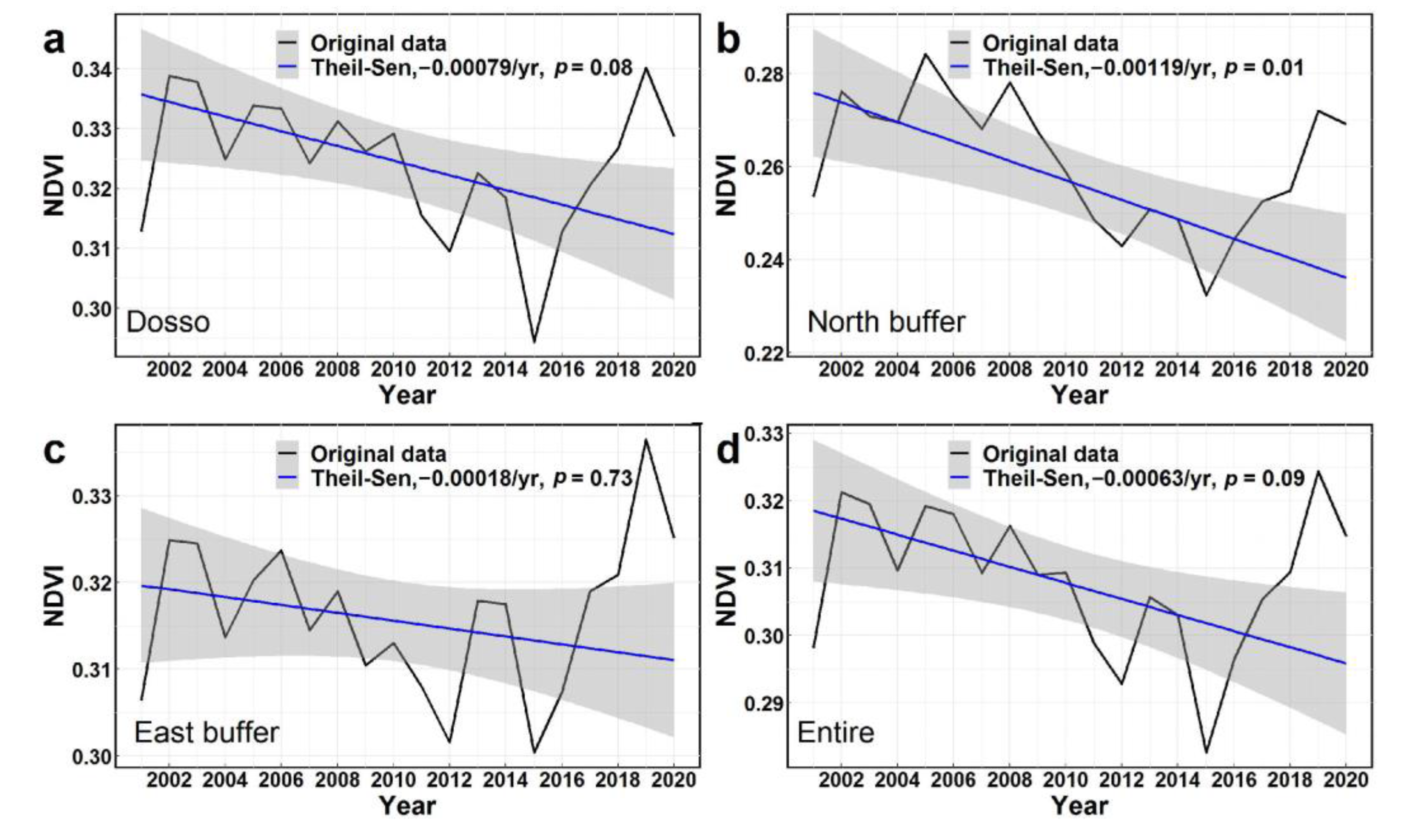
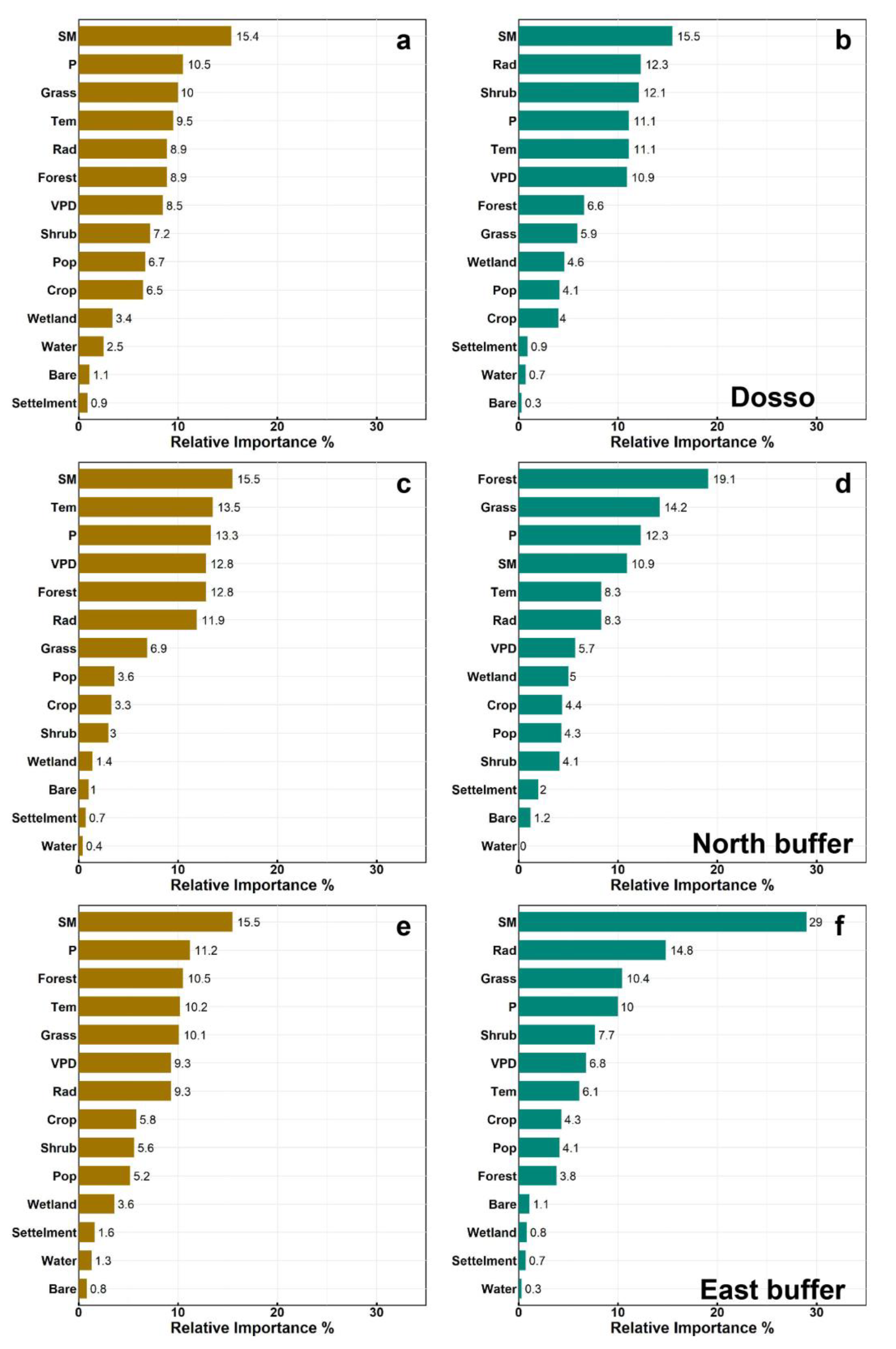
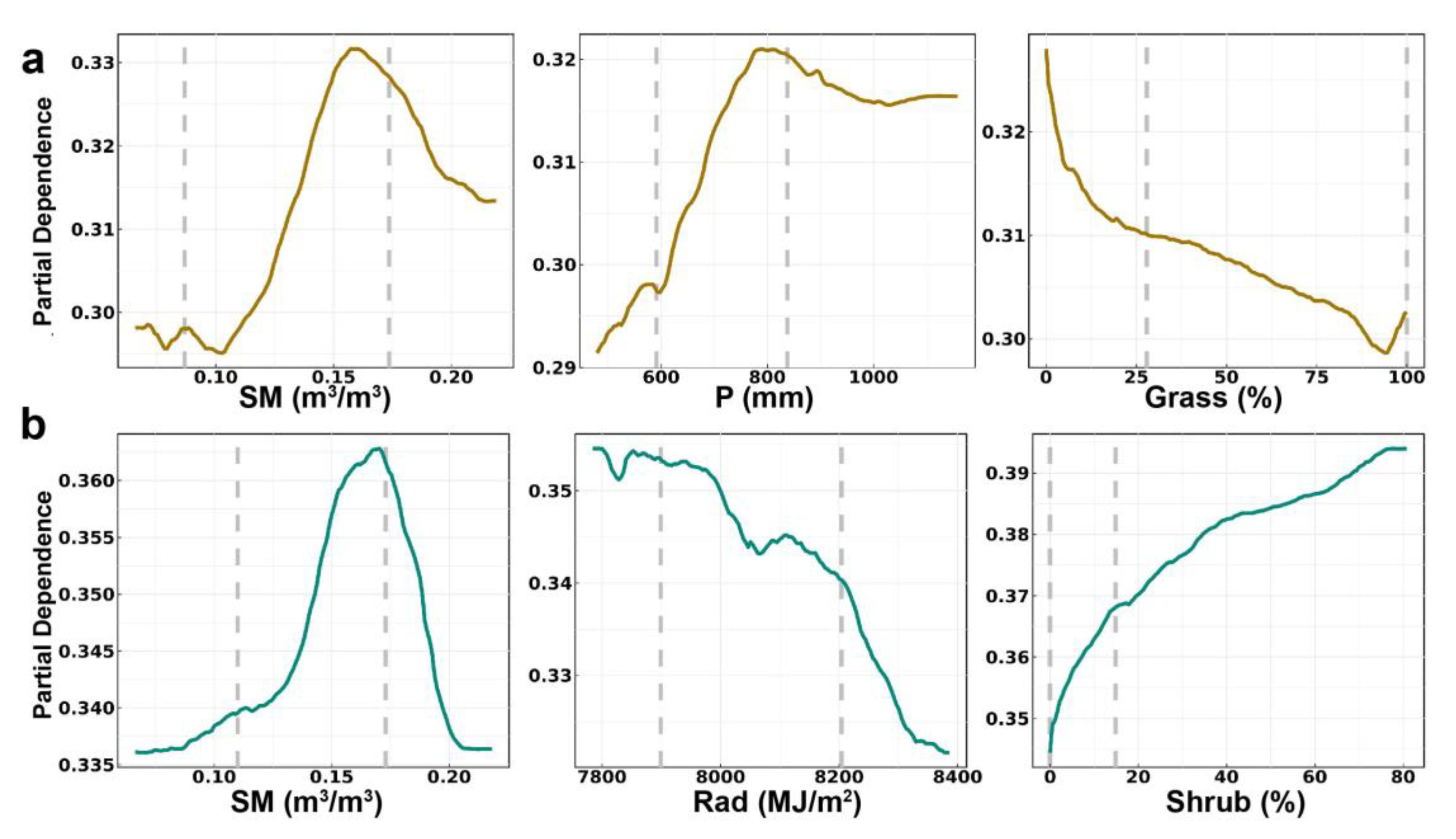
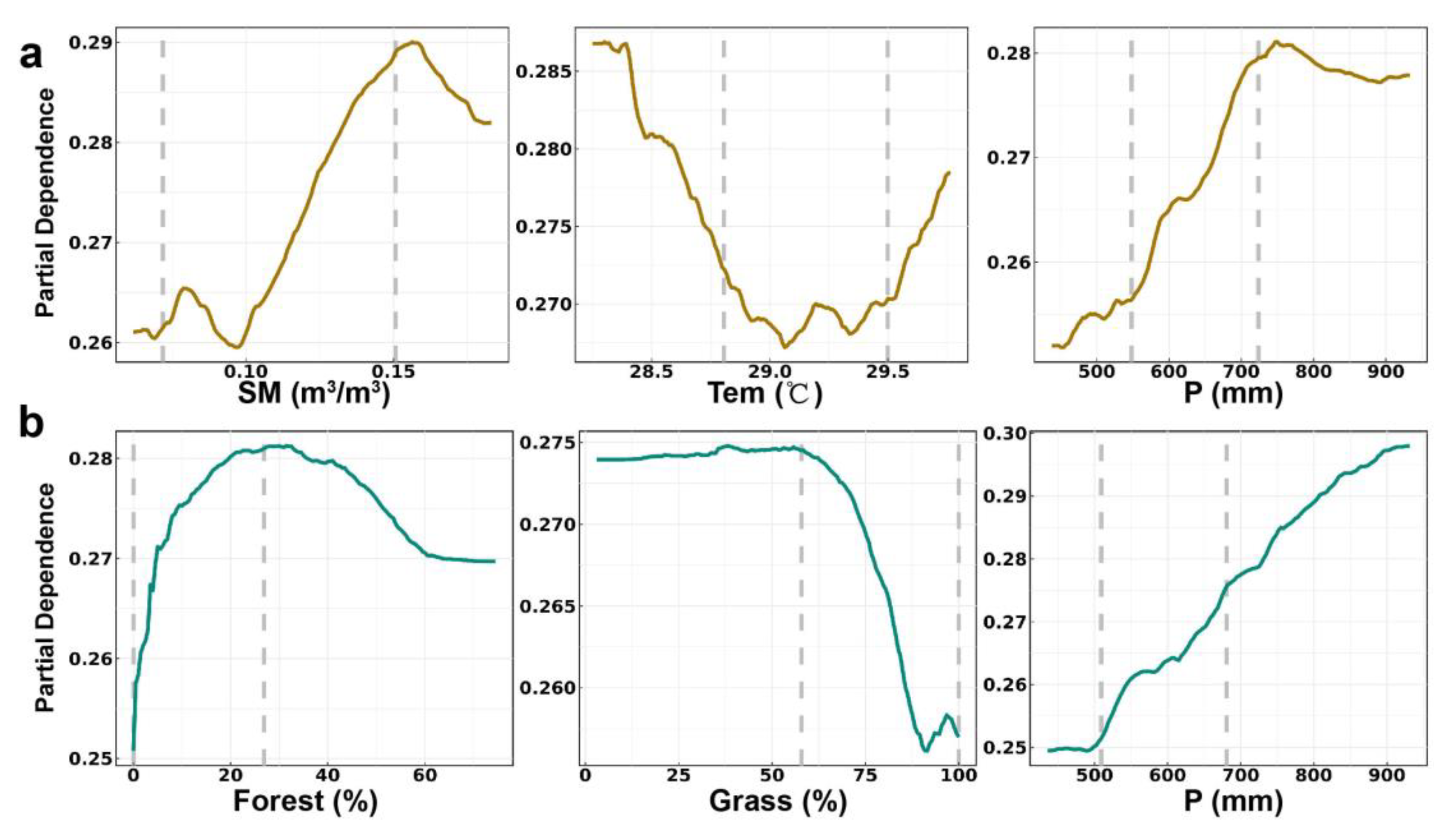
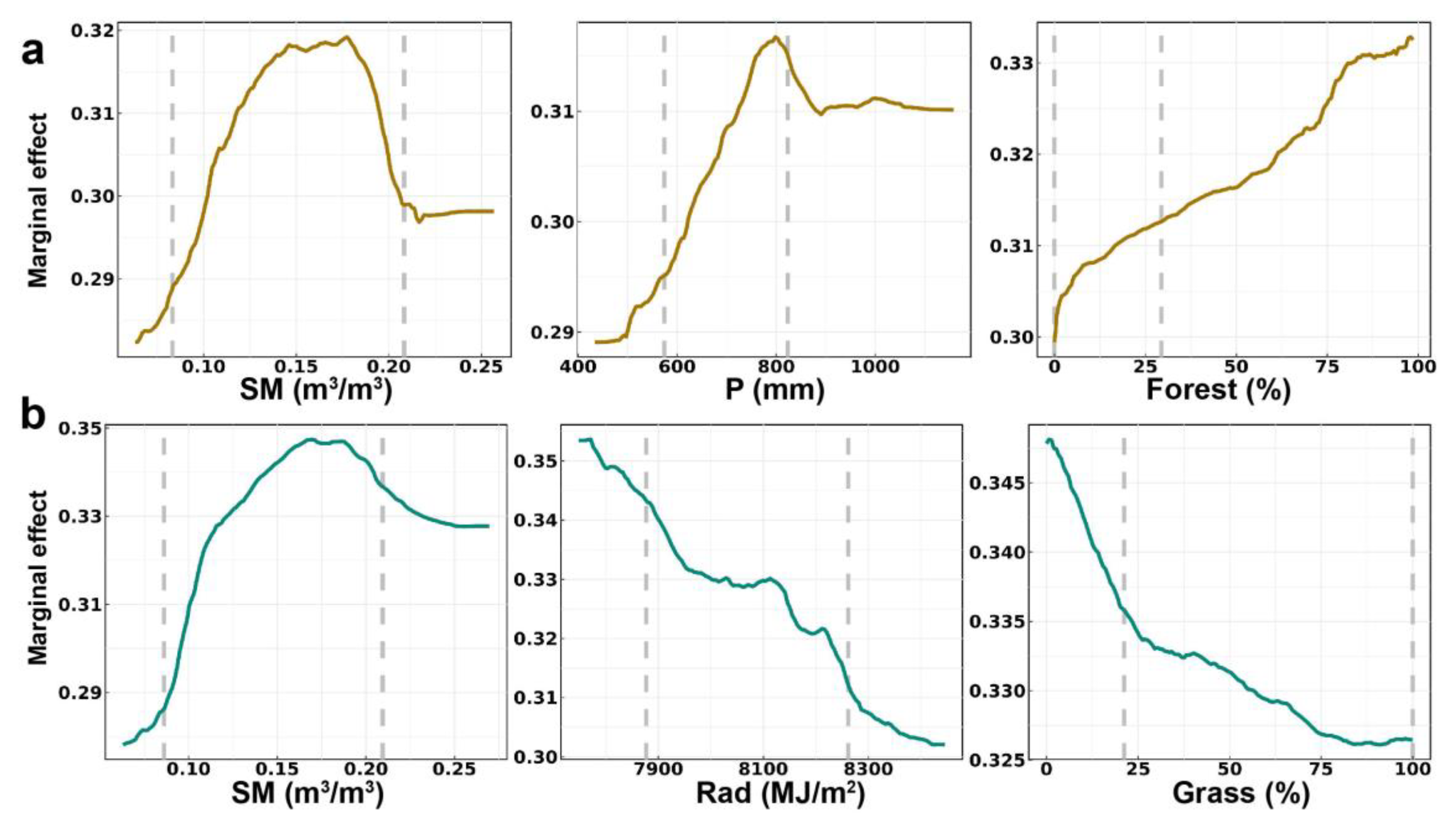
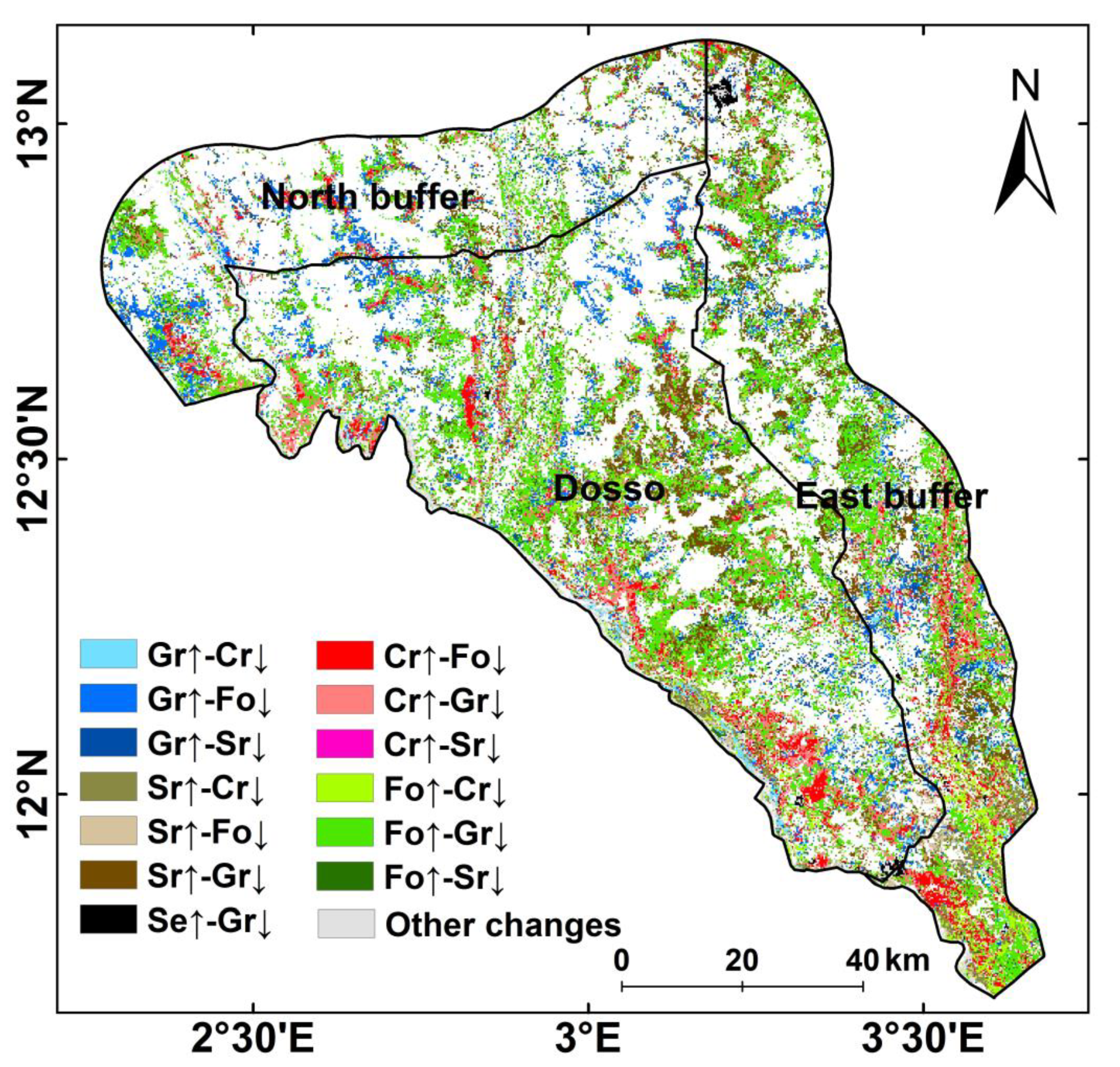
| Variable Type | Variable Name (Unit) | Definition | Data Source |
|---|---|---|---|
| Climate | P (mm/yr) | Annual sum precipitation | CHIRPS |
| Tem (°C) | Annual mean air temperature | ERA5-Land | |
| VPD (hPa) | Annual mean vapor pressure deficit | ERA5-Land | |
| Rad (MJ/m2) | Annual total incoming shortwave solar radiation | ERA5-Land | |
| Soil moisture | SM (m3/m3) | Annual weighted average soil moisture for the whole layer between 0 and 1 m depths | ERA5-Land |
| Land use/land cover change | Fraction in LULC (%) | Yearly fractional abundance of cropland, forest, grassland, shrubland, wetland, water, settlement, and bareland | GLC_FCS30D |
| Population | Pop | Yearly total number of population | WorldPop |
| Reclassification Types in This Paper | Original GLC_FCS30D Types | |
|---|---|---|
| Cropland | 10 | Rainfed cropland |
| 11 | Herbaceous cover cropland | |
| 12 | Tree or shrub cover (Orchard) cropland | |
| 20 | Irrigated cropland | |
| Forest | 51 | Open evergreen broadleaved forest |
| 52 | Closed evergreen broadleaved forest | |
| 61 | Open deciduous broadleaved forest (0.15 < fc < 0.4) | |
| 62 | Closed deciduous broadleaved forest (fc > 0.4) | |
| 71 | Open evergreen needle-leaved forest (0.15 < fc < 0.4) | |
| 72 | Closed evergreen needle-leaved forest (fc > 0.4) | |
| 81 | Open deciduous needle-leaved forest (0.15 < fc < 0.4) | |
| 82 | Closed deciduous needle-leaved forest (fc > 0.4) | |
| 91 | Open mixed-leaf forest (broadleaved and needle-leaved) | |
| 92 | Closed mixed-leaf forest (broadleaved and needle-leaved) | |
| 185 | Mangrove | |
| Grassland | 130 | Grassland |
| 150 | Sparse vegetation (fc < 0.15) | |
| 152 | Sparse shrubland (fc < 0.15) | |
| 153 | Sparse herbaceous (fc < 0.15) | |
| Shrubland | 120 | Shrubland |
| 121 | Evergreen shrubland | |
| 122 | Deciduous shrubland | |
| Wetland | 181 | Swamp |
| 182 | Marsh | |
| 183 | Flooded flat | |
| 184 | Saline | |
| 186 | Salt marsh | |
| 187 | Tidal flat | |
| Water | 210 | Water body |
| Tundra | 140 | Lichens and mosses |
| Settlement | 190 | Impervious surfaces |
| Bareland | 200 | Bare areas |
| 201 | Consolidated bare areas | |
| 202 | Unconsolidated bare areas | |
| Snow/Ice | 220 | Permanent ice and snow |
| Hyper-Parameter | Meaning | Range | Interval | Final Decision |
|---|---|---|---|---|
| mtry | The number of randomly selected features to consider for splitting at each node. | [1, 14] | 1 | 14 |
| splitrule | The criterion used for node splitting. | [‘variance’, ‘extratrees’, ‘maxstat’] | —— | ‘extratrees’ |
| min.node.size | The minimum number of samples allowed in a node. | [1, 8] | 1 | 1 |
| Scenarios | Scenarios Setting | R2 | RMSE |
|---|---|---|---|
| Dosso-B | significant browning in the Dosso Reserve | 0.716 | 0.031 |
| Dosso-G | significant greening in the Dosso Reserve | 0.746 | 0.023 |
| North-B | significant browning in the North buffer region | 0.759 | 0.021 |
| North-G | significant greening in the North buffer region | 0.800 | 0.021 |
| East-B | significant browning in the East buffer region | 0.785 | 0.022 |
| East-G | significant greening in the East buffer region | 0.892 | 0.022 |
Disclaimer/Publisher’s Note: The statements, opinions and data contained in all publications are solely those of the individual author(s) and contributor(s) and not of MDPI and/or the editor(s). MDPI and/or the editor(s) disclaim responsibility for any injury to people or property resulting from any ideas, methods, instructions or products referred to in the content. |
© 2024 by the authors. Licensee MDPI, Basel, Switzerland. This article is an open access article distributed under the terms and conditions of the Creative Commons Attribution (CC BY) license (https://creativecommons.org/licenses/by/4.0/).
Share and Cite
Zeng, Y.; Jia, L.; Jiang, M.; Zheng, C.; Menenti, M.; Bennour, A.; Lv, Y. Hydrological Factor and Land Use/Land Cover Change Explain the Vegetation Browning in the Dosso Reserve, Niger. Remote Sens. 2024, 16, 1728. https://doi.org/10.3390/rs16101728
Zeng Y, Jia L, Jiang M, Zheng C, Menenti M, Bennour A, Lv Y. Hydrological Factor and Land Use/Land Cover Change Explain the Vegetation Browning in the Dosso Reserve, Niger. Remote Sensing. 2024; 16(10):1728. https://doi.org/10.3390/rs16101728
Chicago/Turabian StyleZeng, Yelong, Li Jia, Min Jiang, Chaolei Zheng, Massimo Menenti, Ali Bennour, and Yunzhe Lv. 2024. "Hydrological Factor and Land Use/Land Cover Change Explain the Vegetation Browning in the Dosso Reserve, Niger" Remote Sensing 16, no. 10: 1728. https://doi.org/10.3390/rs16101728
APA StyleZeng, Y., Jia, L., Jiang, M., Zheng, C., Menenti, M., Bennour, A., & Lv, Y. (2024). Hydrological Factor and Land Use/Land Cover Change Explain the Vegetation Browning in the Dosso Reserve, Niger. Remote Sensing, 16(10), 1728. https://doi.org/10.3390/rs16101728









